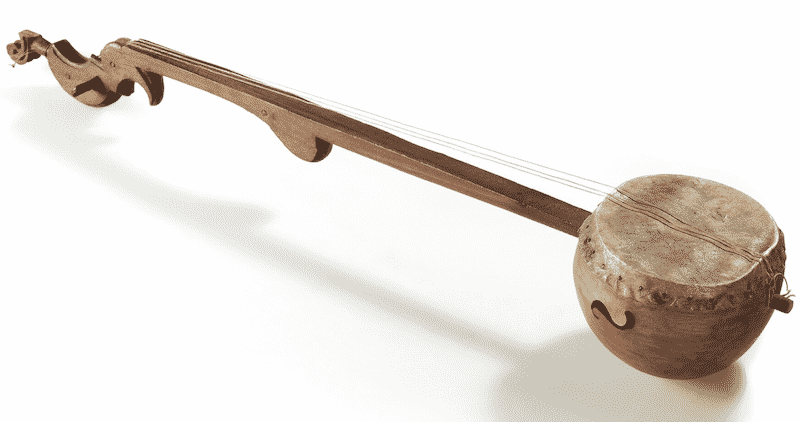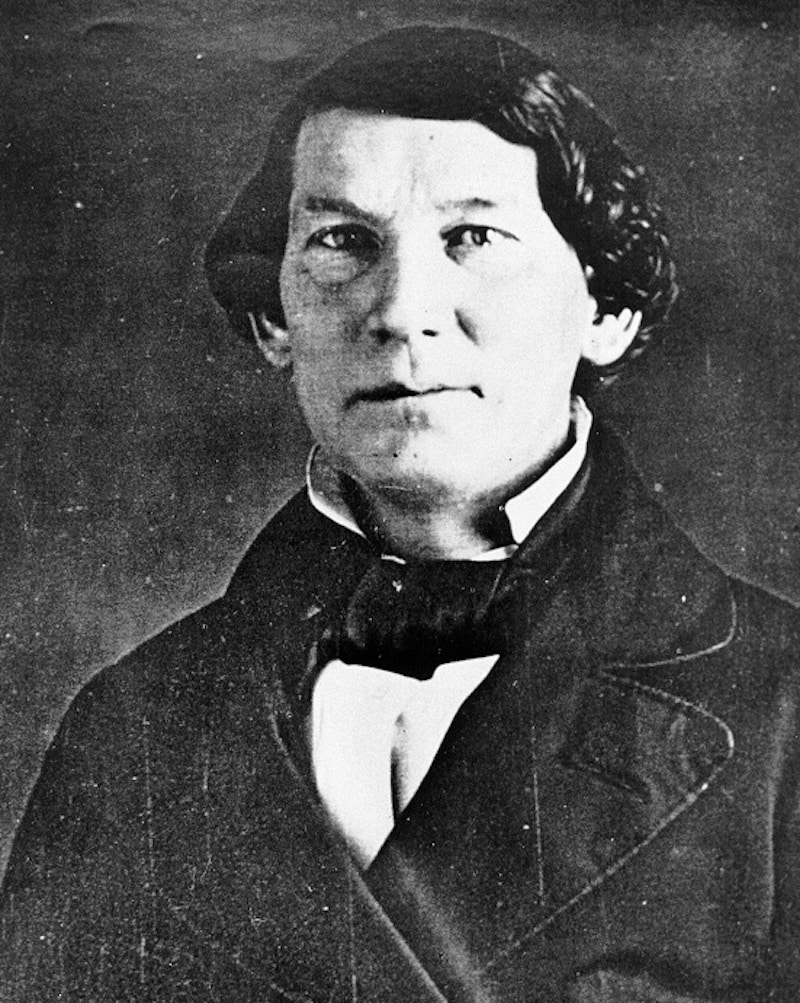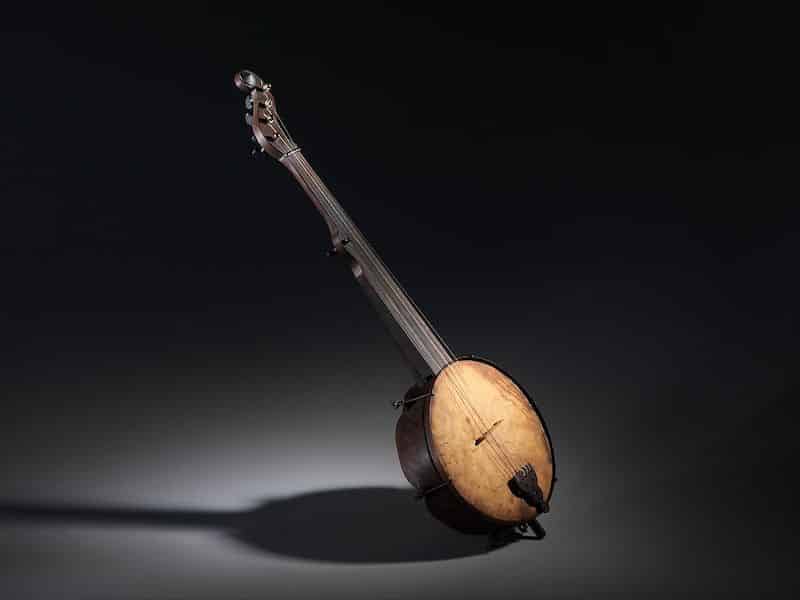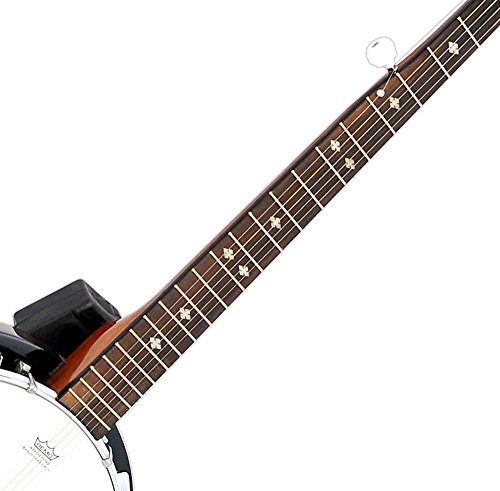Aboard the Clotilda and into the big screen, the banjo never stopped writing history with its tones. Banjo music can reflect pride, anticipation, and even comedy.
It’s hard to describe the sound of the banjo. It’s not just popping, or a twangy eco. To put it simply, the banjo vibrates energy and resilience.
Are you ready to uncover some facts about the banjo that’ll change your perspective?
1. The Banjo is over 400 years old

The earliest references to the banjo date back to the early 1600s.
It’s hard to pinpoint the exact location where the banjo was first created but it’s thought to have been invented by African slaves in the Caribbean.
The image above is the oldest known surviving banjo and is made out of a Calabash gourd, with a sheepskin soundboard and wooden neck and shows what they originally looked like.
2. The Spelling for “Banjo” Changed Over Time… A lot
The way you write the word “banjo” in the 1840s is a lot different than that of the 1700s.
The banjo derived its name from “Bantu Mbanza” which is another African string instrument.
Over time, Bantu became Bangoe, Banza, Banjar, Bania, Banshaw, and finally banjo.
It’s believed that the banjo went through at least 19 different spelling variations most of which were lost in history.
3. Cats Helped Make the Banjo
It wasn’t just the spelling that changed and the banjo itself morphed its structure and materials.
Originally, the banjo was made from animal (cats or goats) skin and a gourd then the banjo maker would stretch four gut strings over it.
Later, the cat skin was replaced by a wooden drum but today, both the drum and strings are made of metals.
4. The Banjo’s History is Tied to Slavery
Africans who were taken as slaves to America recreated the banjo there.
For a long while, it was a means of entertainment and storytelling but it wasn’t until the 19th century that white Americans started to adopt banjo music.
However, when they first played the banjo, it was more mocking than appreciation.
In fact, early minstrel banjo shows went hand in hand with blackface.
5. Joel Sweeney Was the First White Man to Professionally Play the Banjo

Among the first white Americans to play the banjo was controversial musician Joel Sweeney Walker.
Sweeney was a musician from Virginia who did a lot for developing the banjo and was a prominent performer during his day.
He changed animal skin gourds to resonating wood drums and also added the 5th chanterelle string.
Sure, Sweeney had a lot to add to the banjo, but he also performed in blackface.
6. Commercial Production of the Banjo Started in 1845

Once minstrel banjo shows started becoming a hit, the demand for production increased.
William Boucher was a drum maker and banjo player from Baltimore who saw an opportunity in manufacturing banjos.
Soon, Boucher made professional banjos under the brand name Wm. E. Boucher Jr.
Boucher’s banjos were made out of wooden drums and metal screws for tightening the head strings.
Today, Boucher’s original banjos are considered antiques and can cost quite a bit of money.
7. Some Banjos Were Gender-Specific
Boucher’s manufacturing company used to make models that were much smaller in grip and it’s widely believed that these minstrel banjos were made to be played by women.
Some of the theatrical pieces made by Wm. E. Boucher Jr. are also specific for women’s hands.
They have fancy detail-engravings on the neck and the drum is painted to look like rosewood.
Today, you won’t find any gender-specific banjos, these are only found in art exhibits.
8. The Banjo’s 5th String Is Shorter Than the Rest

If you’ve ever seen a modern banjo up close, you’ve probably noticed that one string is shorter than the rest.
This string is called the chanterelle or the drone.
Back when banjo strings used to be made out of cat guts, stretching out a string for a high note wasn’t very practical.
Unlike the remaining strings, the chanterelle didn’t need to reach the peg anyway.
Although today’s steel strings can stretch and keep a high note, the design stuck.
Somehow, manufacturers decided to keep it the way it is.
Maybe it’s something about the optics that keep the instrument looking timeless?
9. Five Strings, Four Notes
Banjos can come with four, five, six, or even seven strings depending on the model, however, most modern American banjos carry five strings.
That’s four identical length strings and a shorter chanterelle.
The strings play four notes when tuned in open G.
The notes are G, D, G, B, and D.
Other banjos can be tuned to Double C, Drop C, or G Modal.
10. The First Banjo Players Were Storytellers
African griots used the banjo as a tool for storytelling to captivate their audience.
Griots were more than just entertainers, they were artists and – in a sense – historians.
They used music and poetry to pass along folklore.
Alongside the ngoni and xalam, the banjo played a role in preserving African history.
11. Minstrel vs Modern
Minstrel banjos were simpler in design and made to accommodate live audience shows.
The minstrel was bigger, wider, and produced a deeper tone, and was also a fretless instrument.
It would be a pain to try and play a minstrel now after being used to the luxury of frets and resonators.
You wouldn’t even be able to play a 3-finger style on a minstrel banjo.
The frets and resonators were added later around 1878 by Henry C. Dobson and it was then mass-produced by the Buckbee Company.
12. Concert Zither + Banjo = Zither Banjo
William Timlet merged two instruments, the German concert zither, and the African banjo.
The resulting 7-string lute was called the zither banjo.
There are a lot of technical differences between classic banjos and zithers.
Yet, what most collectors look for is the vellum (calfskin) head.
Vellum gives the banjo a very distinctive tone regardless of the player’s style.
13. Ukulele + Banjo = Banjolele
The banjolele is a type of ukulele that is a cross between the ukulele and the banjo.
It’s a small four-stringed banjo with a fretted ukulele neck.
Just like the zither banjo, a banjolele’s value increases if it has a vellum head and some people will install the vellum themselves at home.
The key is to tighten the calfskin enough to get a lighter tone, but not too tight that it tears up.
14. Banjos can be Played with Picks or Plectrums
With the rise of Jazz, the banjo started to adapt and change and jazz players found it easier to ditch the chanterelle and use plectrums.
This way, they could get the maximum volume and easy strumming.
However, certain banjos (like the bluegrass) are only played with finger picks.
15. You Can Clawhammer an Open-Back Banjo
The name “clawhammer banjo” didn’t come out of nowhere.
The old technique involves “clawing” your hand around the banjo’s neck.
“Hammering” the banjo means that you strike the string with one finger and then pluck it with the thumb.
16. Archtops Gave the Guitar an Edge Over the Banjo
Initially, jazz bands relied heavily on the banjo as its twang stood out from the drums, trumpets, and trombones.
It was also loud enough to capture the audience. But, that didn’t last long.
Once the archtop became a thing, guitars were louder and more convenient.
The guitar took over and the banjo disappeared from jazz bands slowly.
17. Bonnie and Clyde
Foggy Mountain Breakdown is perhaps one of the most famous banjo tracks out there.
It’s fast-paced enough to keep the watcher on the edge of their seat, but it’s also twangy enough to give a comical touch.
Next time you watch Bonnie and Clyde, keep an eye (or an ear?) out for the car chase scenes.
18. Warner Bros Helped Spread Banjo Music
With iconic movies like Deliverance and Bonnie and Clyde, the banjo became mainstream.
Both movies had amazing banjo tracks — so amazing that the Fans wanted more.
Warner Bros soon had to publish the “Duelling Banjos” album for eager fans!
Interestingly, despite being called “Duelling Banjos,” it is actually a duel between a guitar and a banjo, not two banjos.
19. The Banjo’s Still Relevant Today
Banjos are making a strong comeback.
Its association with African heritage encourages many people to get into banjo music.
If we’re talking about famous modern banjo players, Béla Fleck comes to mind.
Fleck usually plays the bluegrass banjo, though.
Steve Martin, Mark Johnson, Terry Baucom, Dropkick Murphys, Noam Pikelny and many others are giving jaw-dropping performances of the banjo.
20. The Love for Banjo Music Grew with us
Banjo music isn’t limited to fancy events.
It’s everywhere around us from classic movies to Led Zeppelin’s songs.
Many of us grew up listening to the banjo on famous shows like Sesame Street.
Both Béla Fleck and David Mathews made iconic appearances on Sesame Street episodes.
No wonder listening to the banjo fills us with bubbly warmness!
Summing Up Banjo Facts
Through celebration and through despair, banjo players carried their instruments like they carried their hope.
The spelling and the design may change, but the banjo is still a symbol of reclamation and heritage.
We hope these facts about the banjo inspired you to take a look at its rich history.
We’ve only scratched the surface!
